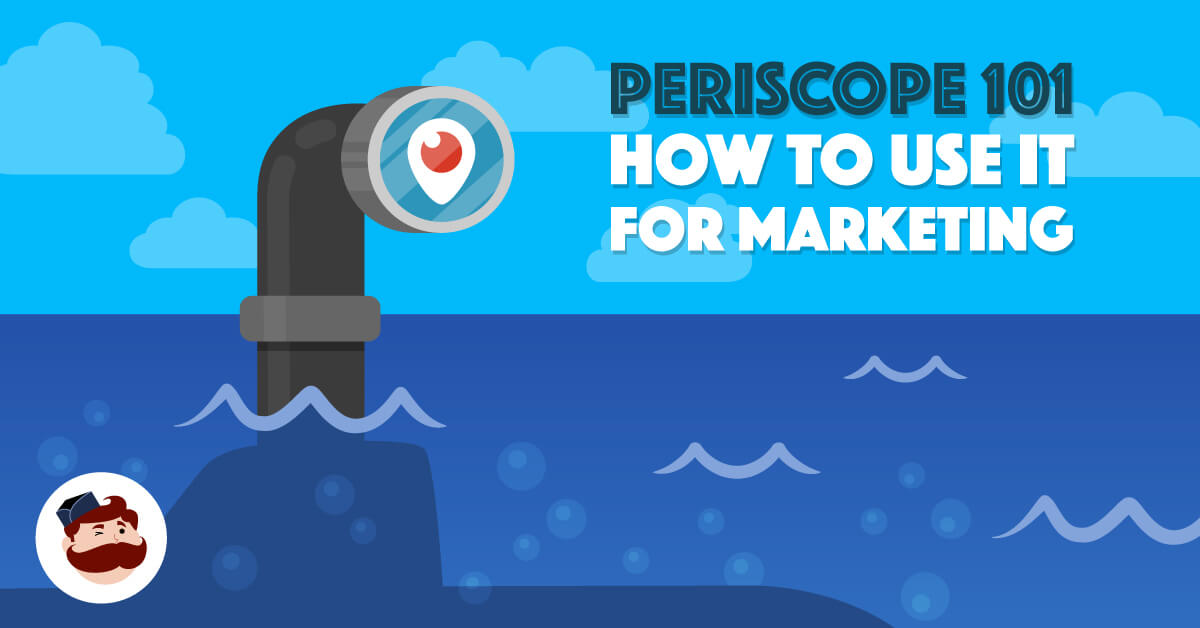
01 Feb Periscope 101: How to Use Periscope For Marketing
[ad_1]
For all the businesses out there struggling to see any traction on Twitter, you are definitely not alone.
It’s difficult to generate consistent engagement on the platform, even when using tons of great practices to optimize for it. Fortunately, there is one tool that can help drive engagement more quickly: Periscope.
Periscope is a live video broadcasting platform linked to Twitter. Both viewers and the video’s creator can share the broadcast to Twitter for increased exposure.
With video holding so much social currency, folding Periscope into your marketing strategy could bolster the results of your Twitter campaigns.
Now that we know why it matters, let’s take a look at how to use Periscope for marketing in SMBs.
How is Periscope Different than Facebook and Instagram Live Video?
It feels like live video is everywhere, right? It seems like every platform has live video, especially with Instagram’s new live stories feature. So the big question is how is Periscope different than Facebook and Instagram Live Video, which many businesses are more familiar with?
Periscope was the first major social platform (as it’s linked to Twitter) that had live broadcasting like we’re most familiar with it today. It is technically a separate site that’s linked to Twitter, similar to how Instagram is linked to Facebook.

Periscope lets users shoot live video broadcasts. Your followers may be notified when you go online (if push notifications are enabled), and your live video can be featured on the home screen of the platform. Users can interact with your video in real-time as you’re broadcasting live. The broadcast will stay on Periscope for 24 hours after the live recording ends, when you can choose to have it auto-delete. Both you and your viewers can share the video to Twitter. This makes it a little like a combination of Facebook Live and Instagram Live; you’ve got the ability to share the broadcast (like Facebook), while it would otherwise disappear (like Instagram)
You can also auto-save your broadcast to your camera roll, so it can be shared on other platforms natively as a recorded video.
Why Use Periscope?
Video is a great tool to gain more traction on Twitter, just like it is on other platforms. It stands out in a feed quickly. This is always a plus, especially when you’re trying to get more followers and more retweets.
Twitter benefits aside, knowing how to use Periscope for marketing has advantages of its own. It’s yet another platform with a large audience, and that may be an audience you haven’t connected with yet. Since Periscope features different live (and recently live) videos on their home page, you can find new followers who are interested in your content and your business. The ability to interact with a video as it’s being broadcast is exciting and dynamic, so you could get great interaction with new users.
What Settings Should You Use?
There are certain settings businesses and brands should always enabled or disabled for their Periscope broadcasts. These settings can give you more control over the broadcast and how it’s saved.
To get to your settings, click the white silhouette in the top right corner of the app.

On the next screen, scroll down to settings.

On this screen, you’ll be able to customize your settings, including saving and comment moderation options.

My recommended settings are:
- Enable video stabilization: on.
- Auto-delete after 24 hours:
- Auto-save to camera-roll: on. This allows you to upload the video natively to other platforms.
- Save in high definition: on. The higher the quality, the better.
- I want to moderate (comments): on. You should always have the ability to moderate comments on; this is a valuable asset.
- Moderate my broadcasts: on. This setting allows other users to report comments and get them hidden, which can take some of the slack off of you while you’re busy creating a great video
Periscope Best Practices
If you want your content to get engagement, views, and shares (which, yes, everyone should) there are some Periscope best practices that you should always use.
You should always:
- Use hashtags in your video description. Periscope is a partnered site with Twitter, after all; it’s not a surprise that hashtags matter here. Hashtags are still searchable, so choosing the right one can help your audience find you.
- You can turn Twitter Post on. Before you start broadcasting live, you can choose to have the broadcast be shared to Twitter as you’re making it. This automates the process and can get you more views.

- Interact in real time with viewers. It can be difficult to balance shooting a great broadcast while answering questions at the same time, but it will benefit your content if you do. Answer questions and address commenters as much as possible.
- Research peak times to post on Twitter. Your followers on Twitter can get notified when you go live on Periscope, and going live is most effective during peak activity hours. Look at Twitter and see when your audience is most active to know what times might get you the best results.
9 Amazing Use Cases for Periscope Marketing
Want to know specific ways to use Periscope for marketing? There are some amazing use cases that can benefit your business, including:
- Feature content to small groups. You can create custom groups of your followers and make your periscope visible to only them. You can use this feature to share exclusive content with membership customers, for example, or use it to get feedback from a focus group.
- Share breaking news. Perhaps nothing fits the excitement of live video quite like exciting breaking news. Once the broadcast is over, make sure you share it to Twitter and other platforms for optimal visibility.
- Host interviews. Influencer marketing still holds a lot of weight with social media, and interviewing customers, peers, or experts is a great live video strategy. Make sure to tag the person you’re influencing to expand your reach.
- Have Q&A’s. Q&As are immensely valuable. Try to have a few questions ready ahead of time in case it takes time for someone to ask one. Encourage users to come up with questions before the broadcast.
- Broadcast in-person events. You get to promote an event and hopefully evoke some FOMO marketing, increasing sales and excitement.
- Promote social contests. Social contests can translate directly into an abundance of lead contact information, so you want to get as many entries as possible. Promote them on periscope for maximum participation.
- Provide interactive customer support. Want to provide more interactive and dynamic customer support. SingleGrain has some ideas for how you can do that here.
- Announce new products. When you announce new products on Periscope, you can see customers react to it in real time. They can ask questions if they have them.
- Demonstrate product tutorials. Tutorials, like Q&As, have value that is immediately recognizable. Showing how to use your products is a fantastic way to promote them.
Final Thoughts
Periscope is dynamic and engaging. It can be used to enhance your Twitter marketing and it has many standalone benefits, too. With the right settings, best practices, and use cases in place, you can see results quickly from the platform—you’ve just got to get started.
What do you think? How do you use Periscope for marketing? Do you use it as part of your Twitter marketing? Leave us a comment and let us know what you think!
[ad_2]
Source link
Social Media Agency, Social Media, Digital Marketing, Digital Marketing Agency, Search Engine Marketing, SEO, digital marketing agency dubai, video content marketing, crossfit marketing dubai, video marketing dubai, digital marketing agency abu dhabi, facebook marketing dubai, facebook marketing abu dhabi, digital marketing agencies in dubai, social media agency, content marketing dubai, content strategy dubai, branding dubai

